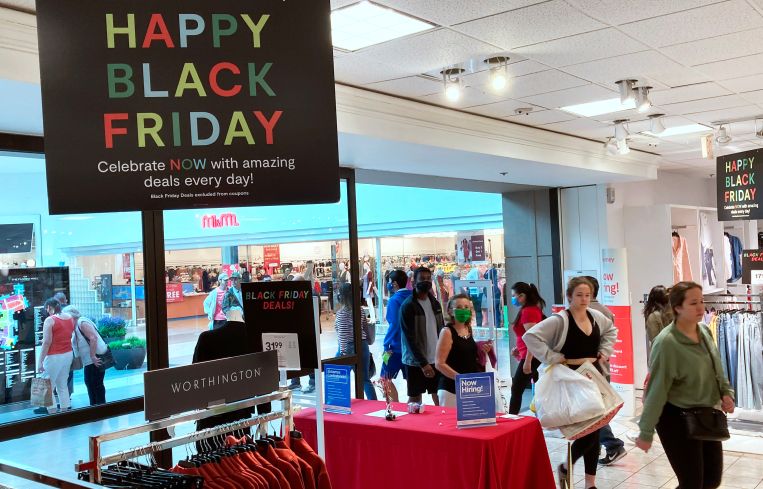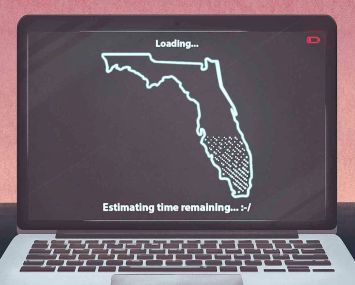Holiday Shopping Season Highlights Proptech’s Bigger Role in Retail
Brick-and-mortar stores, giddy with a rebound in sales, want technology’s help in everything from counting foot traffic to sweeping parking lots
By Philip Russo October 31, 2023 9:00 am
reprints
Aided by consumer spending growth that continues to defy economists’ expectations, the nation’s gross domestic product increased 4.9 percent in the third quarter. And as we enter the holiday shopping season, that growing consumer demand is leading brick-and-mortar retail landlords and tenants to depend more on proptech to aid them with a variety of issues accompanying this greater number of shoppers.
Additionally, as online shopping margins compress, proptech that helps facilitate retail stores and malls is increasingly in demand, according to experts.
“From a retail and shopping center perspective, I think there’s certainly more of a focus on loss prevention than there’s been in the past,” said David Blumenfeld, who along with Kyle Spencer, started NextRivet, a San Francisco-based proptech consulting firm founded in 2019 that helps mall operators integrate technology solutions into physical stores in an effort to compete with e-commerce. It also helps landlords partner with retailers to drive greater demand.
“There is a wave, obviously, of additional crime and theft that’s happening not everywhere, but certainly more so than we’ve seen in the past,” said Blumenfeld. “I think retailers, shopping centers and landlords are very aware of trying to implement systems, whether it’s camera-based systems or physical security. I don’t think anybody has it all figured out yet, but I think there’s growing demand and attention from the landlords and the retailers to collaborate on the issue and not just try to go it alone.”
Beyond theft concerns, Spencer pointed to “spatial analytics” as an important focus for landlords and retailers entering the holiday shopping season. Property owners feel the need to better understand shopper traffic patterns and to use predictive analytics to streamline operations, he said.
“There’s been a movement over the last two to three years, and even probably a little bit more, of software companies coming in,” Spencer said. “In the past, you’d have to put up beacons and use Wi-Fi triangulation, or different methods of understanding traffic patterns, and people counting in the old sense. Now you’re able to tap into the existing CCTV cameras that people already have in the malls, put a software layer on top of that, and start to get a better understanding of consumers being tracked.”
NextRivet isn’t the only company seeing opportunity in a stronger brick-and-mortar retail market this season.
“We’ve seen it pick up a lot compared to what it was probably a year ago,” said Chaim Schwartz, CEO of Finance Lobby, a Miami-based digital marketplace for commercial real estate financing, which last week announced a partnership with Placer.ai, a leading location data platform for CRE and retailers. “We’ve seen a lot of it increase in terms of demand on our end of deals posted, and on the flip side in what the lenders are offering. We integrated Placer.ai to specifically benefit any user on our platform on the retail side. You have tremendous data from Placer.ai.”
Proptech startups are addressing the brick-and-mortar retail market in a variety of other ways.
One such company is Manhattan-based Re/tell, a business-to-business marketplace and booking platform that matches online brands with excess space inside high-traffic retail locations.
“The demand is insane,” said Joy Fan, CEO and founder of Re/tell, which opened with a soft launch in March 2022 and has been fully operational for the last six months. “More and more online brands are looking for omnichannel ways to acquire their consumers and we are their first stop.”
The increasingly high cost of advertising and placement online is pushing more businesses to seek shelf space in stores, said Fan, adding that Re/tell has “1,500 brands in our ecosystem and it’s growing.
“They’re looking at different offerings, whether it be physical retail, wholesale, you name it — what would be a better way for them to acquire the consumer and also create loyalty and community?” she said. “So we created a recommendation engine that makes it easy for online brands to get matched into a space and able to offer their product through activation, sampling, and creating an experience for $15 to $150 daily for shelf space.”
Another proptech startup taking advantage of the in-store marketplace is SOS, a Boston-based, female-founded wellness company that uses a network of smart vending machines.
Last week, SOS announced an exclusive partnership with Ulta Beauty, the nation’s largest beauty retailer.The pilot aims to elevate Ulta Beauty’s in-store sampling program and test its first-ever digital in-store advertising program to try to deepen customer engagement and drive growth for brand partners. The SOS vending machines will also offer complimentary Rael period care products for Ulta Beauty guests, providing more access to necessities in stores.
“At Ulta Beauty, we are committed to delivering new, engaging ways for guests to experience, try, and fall in love with new products,” Maria Salcedo, senior vice president of merchandising at Ulta Beauty, said in a statement. “Through our pilot program with SOS, we have the ability to learn how guests are engaging with vending machines and digital brand touch points in-store, opening up new opportunities to transform the beauty shopping experience.”
From a proptech investor perspective, compressed yields and pressure from private equity owners to increase profits from malls and other retail properties is adding to the demand for technology that can reduce costs and improve efficiencies, said Raja Ghawi, a partner at Era Ventures, a Manhattan-based proptech venture capital firm.
“As you think about big-box retailers and strip malls, those operations tend to be a little bit more optimized, and we’re starting to see some interesting stuff on cost cutting,” said Ghawi. “We’re hearing from a bunch of national operators that they are sitting down reviewing all their cost items one by one and trying to see where they can use technology to reduce costs, or at least meaningfully improve service.
“So, could you replace your sweeper service providers for your parking lots with a robot? Could you, instead of having an inspector come over, use computer vision and camera data to do inspections of the lighting outside your mall? Instead of using a traditional lawn mower, could you use something that uses automation? We’re seeing a lot of these robotics for space come up.”
Robotics and hardware plays are gaining a lot of traction with investors and owners, Ghawi added. The technology is rapidly maturing and the cost of hardware is falling, he said, making operations that can be automated up to 25 percent cheaper. This intersection also arrives amid what Ghawi described as “a massive labor shortage” in companies that service retailers.
“So the cost of technology is coming down and the cost of people is going up,” he said. “They’re intersecting. That is where it’s starting to make more and more sense to switch from people to robots. We’re starting to see that in the simplest and most repetitive of tasks. Over time, you’re going to see that robots are able to replace more and more humans in less simple and potentially even less repetitive tasks.”
Such an arguably dystopian automated future for brick-and-mortar retail is not necessarily a given, though, said Nikki Greenberg, founder and chief innovation officer at Real Estate of the Future, a Manhattan-based advisory firm for commercial real estate and proptech companies.
“One way e-commerce has an advantage over brick-and-mortar retail is that we can actually get very good analytics on who the customer is because of that online experience,” said Greenberg. “You can learn about their demographics, where they’re located, their income, etc. But, when it comes to brick-and-mortar retail, it’s very difficult to get that same level of analytics around the customer, because it’s a person moving through space and because of privacy considerations.”
Tenants then are asking for more sophisticated data about customers coming into stores because they are used to getting that information now from the online experience, Greenberg said.
“One way you report the health of a shopping center to your tenants is foot traffic,” she said. “Are you bringing customers to the shopping center on behalf of the retailers? It’s incredibly important. But one of the problems is that even something as simple as counting people, despite all the fantastic technology that we have, we can’t even count people accurately.
“There’s examples of shopping centers using heat sensors to be able to tell that a person is in the store,” Greenberg added. “However, these heat sensors would actually sometimes count roasted chickens as people, because it’s been picking up on the heat.”
Perhaps the bottom line for brick-and-mortar retail this holiday shopping season is don’t count your customers before they’ve hatched.
Philip Russo can be reached at prusso@commercialobserver.com.


